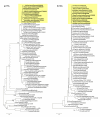First introduction of highly pathogenic H5N1 avian influenza A viruses in wild and domestic birds in Denmark, Northern Europe
- PMID: 17498292
- PMCID: PMC1876802
- DOI: 10.1186/1743-422X-4-43
First introduction of highly pathogenic H5N1 avian influenza A viruses in wild and domestic birds in Denmark, Northern Europe
Abstract
Background: Since 2005 highly pathogenic (HP) avian influenza A H5N1 viruses have spread from Asia to Africa and Europe infecting poultry, humans and wild birds. HP H5N1 virus was isolated in Denmark for the first time in March 2006. A total of 44 wild birds were found positive for the HP H5N1 infection. In addition, one case was reported in a backyard poultry flock.
Results: Full-genome characterisation of nine isolates revealed that the Danish H5N1 viruses were highly similar to German H5N1 isolates in all genes from the same time period. The haemagglutinin gene grouped phylogenetically in H5 clade 2 subclade 2 and closest relatives besides the German isolates were isolates from Croatia in 2005, Nigeria and Niger in 2006 and isolates from Astrakhan in Russia 2006. The German and Danish isolates shared unique substitutions in the NA, PB1 and NS2 proteins.
Conclusion: The first case of HP H5N1 infection of wild and domestic birds in Denmark was experienced in March 2006. This is the first full genome characterisation of HP H5N1 avian influenza A virus in the Nordic countries. The Danish viruses from this time period have their origin from the wild bird strains from Qinghai in 2005. These viruses may have been introduced to the Northern Europe through unusual migration due to the cold weather in Eastern Europe at that time.
Figures




References
-
- Gorman OT, Bean WJ, Webster RG. Evolutionary processes in influenza viruses: divergence, rapid evolution, and stasis. Curr Top Microbiol Immunol. 1992;176:75–97. - PubMed
-
- Fouchier RA, Munster V, Wallensten A, Bestebroer TM, Herfst S, Smith D, Rimmelzwaan GF, Olsen B, Osterhaus AD. Characterization of a novel influenza a virus hemagglutinin subtype (H16) obtained from black-headed gulls. J Virol. 2005;79:2814–2822. doi: 10.1128/JVI.79.5.2814-2822.2005. - DOI - PMC - PubMed
Publication types
MeSH terms
Substances
Associated data
- Actions
- Actions
- Actions
- Actions
- Actions
- Actions
- Actions
- Actions
- Actions
- Actions
- Actions
- Actions
- Actions
- Actions
- Actions
- Actions
- Actions
- Actions
- Actions
- Actions
- Actions
- Actions
- Actions
- Actions
- Actions
- Actions
- Actions
- Actions
- Actions
- Actions
- Actions
- Actions
- Actions
- Actions
- Actions
- Actions
- Actions
- Actions
- Actions
- Actions
- Actions
- Actions
- Actions
- Actions
- Actions
- Actions
- Actions
- Actions
- Actions
- Actions
- Actions
- Actions
- Actions
- Actions
- Actions
- Actions
- Actions
- Actions
- Actions
- Actions
- Actions
- Actions
- Actions
- Actions
- Actions
- Actions
- Actions
- Actions
- Actions
- Actions
- Actions
- Actions
- Actions
- Actions
- Actions
- Actions
- Actions
- Actions
- Actions
- Actions
- Actions
- Actions
- Actions
LinkOut - more resources
Full Text Sources
Medical
Research Materials
Miscellaneous

